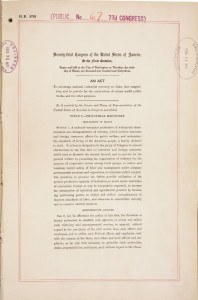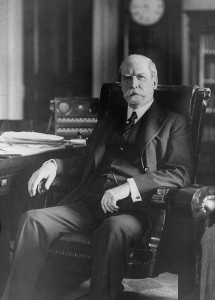The National Industrial Recovery Act (the “NIRA”) was a law passed by the United States Congress in 1933 in response to the unemployment and poverty that swept the nation in the early 1930s. The NIRA authorized the President to regulate industry in an attempt to raise prices after severe deflation and stimulate economic recovery, as well as provided for the establishment of local codes to ensure fair competition in industry.
The NIRA also established the Public Works Administration (the “PWA”), a national public works program, and the National Recovery Administration (the “NRA”), which was largely involved in crafting industrial codes for industries to adopt in order to achieve the desired industrial recovery. The legislation was enacted after being passed by both the House and the Senate, and signed into law by Franklin D. Roosevelt on June 16, 1933 (during the Great Depression) as part of FDR’s ‘New Deal’ legislation.

The Act was then implemented by the PWA and NRA, and numerous regulations were passed under the authority the Act granted the NRA. The Act had two main sections of interest, Title I and Title II.
Title I
Title I was targeted at industrial recovery and included the introduction of industrial codes to ensure fair competition, trade union rights, regulation of working standards, and regulation of prices of certain refined petroleum products and the transportation of those products. The codes were written by private trade and industrial groups, and if the president approved the codes, they became law. Businesses were also required to display a Blue Eagle insignia from the NRA to signify compliance with the codes. Typical local codes included set minimum wages, maximum work hours, and set out workers’ rights to organize, unionize, and engage in collective bargaining with management. Additionally, these codes often prescribed fair trade practices and set minimum prices for the sale of the manufactured goods.
Title I, Breakdown of Important Provisions:
Title I, Section 2 empowered the President to establish executive branch agencies to carry out the purposes of the Act, and included a ‘sunset provision’ nullifying the Act in two years;
Title I, Section 3 permitted trade or industrial associations to seek presidential approval of codes of fair competition (so long as such codes did not promote monopolies or provide unfair competition against small businesses) and provided for enforcement of these codes;
Title I, Section 5 exempted the codes from federal antitrust laws;
Title I, Section 7(a) guaranteed rights of workers to form unions and collectively bargain with management, as well as banned ‘yellow-dog contracts’;
Title I, Section 7(b) permitted establishment of standards for maximum hours of labor, minimum rates of pay, and working conditions in industries covered by the codes;
Title I, Section 7(c) authorized the President to impose the standards mentioned in the previous section on codes when voluntary agreement could not be reached;
Title I, Section 9 authorized regulation of oil pipelines and prices for transportation by pipeline of all petroleum products; and
Title I, Section 9(b) permitted the executive to take over any oil pipeline company, subsidiary, or business if the parent company was found in violation of the Act.
Title II
Title II is the section that created the PWA and outlined the funding and responsibilities that the PWA would take part in, as well as the overall funding for the Act itself. Roosevelt, a former head of a trade association himself, believed that government promotion of “self-organization” by trade associations was the least-intrusive and yet most effective method for achieving national planning and economic improvement.
Title II, Breakdown of Important Provisions:
Title II, Section 201 established the PWA and provided for a two-year ‘sunset provision’;
Title II,Section 202 outlines the types of public works which the PWA may seek to fund or build;
Title II, Section 203 authorized the PWA to provide grants and/or loans to states and localities to more rapidly reduce unemployment, as well as to use the power of eminent domain to seize land or materials to engage in these projects;
Title II, Section 204 provided $400 million for construction of public highways, bridges, roads, railroad crossings, paths, and other transportation projects;
Title II, Section 208 authorized the president to expend up to $25 million to purchase farms to relocate individuals living in overcrowded urban areas to farms and allowing them to raise crops and earn a living there; and
Title II, Sections 210–219 provided for revenues to fund the Act, and Section 220 appropriated money for implementation of the Act.
Title III
Title III of the Act contained miscellaneous provisions and transferred the authority to engage in public works from the Reconstruction Finance Corporation to the Public Works Administration.

The NIRA was set to expire by June, 1935, but was declared unconstitutional by the Supreme Court in 1935 in the Supreme Court case A. L. A. Schechter Poultry Corporation v. U.S., 295 U.S. 495 (1935). The major provision under review in this case was the “Live Poultry Code”, which was approved by the President on April 13, 1934. The code contained eight articles that described its intent and scope, such as purposes, definitions, hours, wages, general labor provisions, administration, trade practice provisions, and general provisions. The intended purpose of the code was to enact policies under Title I of the NIRA and to establish a code of fair competition in the city of New York. Section 3 of the Act authorized the president to regulate unfair competition in business by implementing industrial codes to regulate weekly employment hours, wages, and minimum ages of employees, and such codes had standing as penal statutes in that regard. The legal question to be decided by the Supreme Court was whether Congress had unconstitutionally delegated legislative power to the President through the implementation of .

The Schechter case was decided within the same time frame as similar Supreme Court decisions that also resulted in the striking down of federal attempts to remedy economic crises that resulted from the Great Depression. This decision was especially detrimental to the FDR administration, as the NIRA was a major key in FDR’s new deal legislation aimed at stabilizing and revitalizing the economy. FDR even went as far as to declare that the Court’s definition of interstate commerce was an obstacle to national health.
The specific reasons for the failure of the NIRA are still debated today, and many of the suggested causes include that the Act promoted economically harmful monopolies, that it lacked critical support from the business community, and that it was poorly administered. Additionally, because the Act encouraged unionization of workers, significant labor unrest was a result, which brought to light the other problem–that the NIRA had no mechanism in place to manage the resulting problems. This issue prompted the passage of the National Labor Relations Act of 1935.
Sources & Further Readings:
Pub.L. 73–67, 48 Stat. 195, enacted June 16, 1933, codified at 15 U.S.C. § 703
A.L.A. Schechter Poultry Corp. v. United States, 295 U.S. 495, 55 S. Ct. 837, 79 L. Ed. 1570 (1935)
Barber, William J. From New Era to New Deal: Herbert Hoover, the Economists, and American Economic Policy, 1921–1933. Paperback ed. New York: Cambridge University Press, 1989.
J. M. “Constitutional Law: National Industrial Recovery Act.” Michigan Law Review 33, no. 8 (1935): 1254-256. doi:10.2307/1282372.
“Our Documents”. National Industrial Recovery Act. National Archives. Retrieved Dec. 11, 2016.
https://www.oyez.org/cases/1900-1940/295us495
Schechter Poultry Corp. v. United States – Further Readings – Court, Code, Live, and Roosevelt – JRank Articles (Access online at: http://law.jrank.org/pages/10018/Schechter-Poultry-Corp-v-United-States.html#ixzz4SYCYZS82)